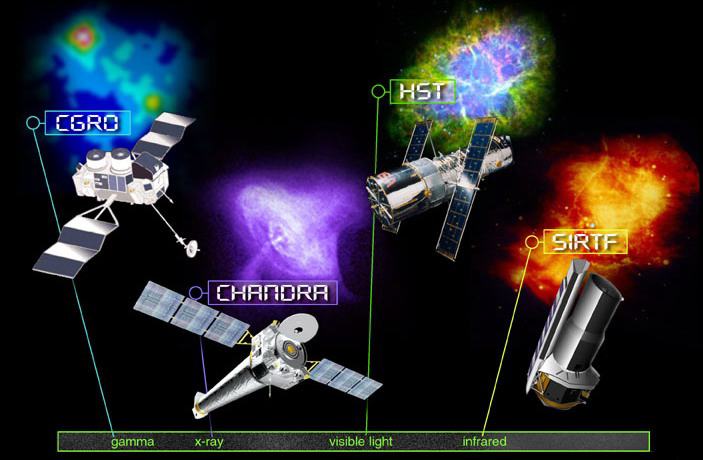|
Bursting Pulsar
The Bursting Pulsar (GRO J1744-28) is a low-mass x-ray binary with a period of 11.8 days. It was discovered in December 1995 by the Burst and Transient Source Experiment on the Compton Gamma-Ray Observatory, the second of the NASA Great Observatories. The pulsar is unique in that it has a "bursting phase" where it emits gamma rays and X-rays peaking at approximately 20 bursts per hour after which the frequency of bursts drops off and the pulsar enters a quiescent phase. After a few months, the bursts reappear, though not yet with predictable regularity. The Bursting Pulsar is the only known X-ray pulsar that is also a Type II X-ray burster.F. Daigne1, P. Goldoni, P. Ferrando1, A. Goldwurm, A. Decourchelle and R. S. Warwick, ''XMM-Newton observation of the bursting pulsar GRO J1744-28 in quiescence'' Astronomy & Astrophysics ''Astronomy & Astrophysics'' is a monthly peer-reviewed scientific journal covering theoretical, observational, and instrumental astronomy and ... [...More Info...] [...Related Items...] OR: [Wikipedia] [Google] [Baidu] |
Sagittarius (constellation)
Sagittarius is one of the constellations of the zodiac and is located in the Southern celestial hemisphere. It is one of the 48 constellations listed by the 2nd-century astronomer Ptolemy and remains one of the 88 modern constellations. Its old astronomical symbol is (♐︎). Its name is Latin for "archer". Sagittarius is commonly represented as a centaur pulling back a bow. It lies between Scorpius and Ophiuchus to the west and Capricornus and Microscopium to the east. The center of the Milky Way lies in the westernmost part of Sagittarius (see Sagittarius A). Visualizations As seen from the northern hemisphere, the constellation's brighter stars form an easily recognizable asterism known as "the Teapot". The stars δ Sgr (Kaus Media), ε Sgr (Kaus Australis), ζ Sgr (Ascella), and φ Sgr form the body of the pot; λ Sgr (Kaus Borealis) is the point of the lid; γ2 Sgr (Alnasl) is the tip of the spout; and σ Sgr (Nunki) and τ Sgr the handle. These same sta ... [...More Info...] [...Related Items...] OR: [Wikipedia] [Google] [Baidu] |
Gamma Ray
A gamma ray, also known as gamma radiation (symbol γ or \gamma), is a penetrating form of electromagnetic radiation arising from the radioactive decay of atomic nuclei. It consists of the shortest wavelength electromagnetic waves, typically shorter than those of X-rays. With frequencies above 30 exahertz (), it imparts the highest photon energy. Paul Villard, a French chemist and physicist, discovered gamma radiation in 1900 while studying radiation emitted by radium. In 1903, Ernest Rutherford named this radiation ''gamma rays'' based on their relatively strong penetration of matter; in 1900 he had already named two less penetrating types of decay radiation (discovered by Henri Becquerel) alpha rays and beta rays in ascending order of penetrating power. Gamma rays from radioactive decay are in the energy range from a few kiloelectronvolts (keV) to approximately 8 megaelectronvolts (MeV), corresponding to the typical energy levels in nuclei with reasonably long lif ... [...More Info...] [...Related Items...] OR: [Wikipedia] [Google] [Baidu] |
Pulsars
A pulsar (from ''pulsating radio source'') is a highly magnetized rotating neutron star that emits beams of electromagnetic radiation out of its magnetic poles. This radiation can be observed only when a beam of emission is pointing toward Earth (similar to the way a lighthouse can be seen only when the light is pointed in the direction of an observer), and is responsible for the pulsed appearance of emission. Neutron stars are very dense and have short, regular rotational periods. This produces a very precise interval between pulses that ranges from milliseconds to seconds for an individual pulsar. Pulsars are one of the candidates for the source of ultra-high-energy cosmic rays. (See also centrifugal mechanism of acceleration.) The periods of pulsars make them very useful tools for astronomers. Observations of a pulsar in a binary neutron star system were used to indirectly confirm the existence of gravitational radiation. The first extrasolar planets were discovered aroun ... [...More Info...] [...Related Items...] OR: [Wikipedia] [Google] [Baidu] |
Astronomy & Astrophysics
''Astronomy & Astrophysics'' is a monthly peer-reviewed scientific journal covering theoretical, observational, and instrumental astronomy and astrophysics. The journal is run by a Board of Directors representing 27 sponsoring countries plus a representative of the European Southern Observatory. The journal is published by EDP Sciences and the editor-in-chief is . History Origins ''Astronomy and Astrophysics'' (A&A) was created as an answer to the publishing scenario found in Europe in the 1960s. At that time, multiple journals were being published in several countries around the continent. These journals usually had a limited number of subscribers, and published articles in languages other than English, resulting in a small number of citations compared to American and British journals. Starting in 1963, conversations between astronomers from European countries assessed the need for a common astronomical journal. On 8 April 1968, leading astronomers from Belgium, Denmark, Franc ... [...More Info...] [...Related Items...] OR: [Wikipedia] [Google] [Baidu] |
X-ray Burster
X-ray bursters are one class of X-ray binary stars exhibiting X-ray bursts, periodic and rapid increases in luminosity (typically a factor of 10 or greater) that peak in the X-ray region of the electromagnetic spectrum. These astrophysical systems are composed of an accreting neutron star and a main sequence companion 'donor' star. There are two types of X-ray bursts, designated I and II. Type I bursts are caused by thermonuclear runaway, while type II arise from the release of gravitational (potential) energy liberated through accretion. For type I (thermonuclear) bursts, the mass transferred from the donor star accumulates on the surface of the neutron star until it ignites and fuses in a burst, producing X-rays. The behavior of X-ray bursters is similar to the behavior of recurrent novae. In that case the compact object is a white dwarf that accretes hydrogen that finally undergoes explosive burning. The compact object of the broader class of X-ray binaries is either a neu ... [...More Info...] [...Related Items...] OR: [Wikipedia] [Google] [Baidu] |
X-ray Pulsar
X-ray pulsars or accretion-powered pulsars are a class of astronomical objects that are X-ray sources displaying strict periodic variations in X-ray intensity. The X-ray periods range from as little as a fraction of a second to as much as several minutes. Characteristics An X-ray pulsar consists of a magnetized neutron star in orbit with a normal stellar companion and is a type of binary star system. The magnetic-field strength at the surface of the neutron star is typically about 108 Tesla, over a trillion times stronger than the strength of the magnetic field measured at the surface of the Earth (60 μT). Gas is accreted from the stellar companion and is channeled by the neutron star's magnetic field on to the magnetic poles producing two or more localized X-ray hot spots, similar to the two auroral zones on Earth, but far hotter. At these hotspots the infalling gas can reach half the speed of light before it impacts the neutron star surface. So much gravitational potentia ... [...More Info...] [...Related Items...] OR: [Wikipedia] [Google] [Baidu] |
Quiescent
Quiescence (/kwiˈɛsəns/) is a state of quietness or inactivity. It may refer to: * Quiescence search, in game tree searching (adversarial search) in artificial intelligence, a quiescent state is one in which a game is considered stable and unlikely to change drastically the next few plays * Seed dormancy, a form of delayed seed germination * Quiescent phase, the first part of the first stage of childbirth * The G0 phase of a cell in the cell cycle; quiescence is the state of a cell when it is not dividing * Quiescent current In electronics, biasing is the setting of DC (direct current) operating conditions (current and voltage) of an active device in an amplifier. Many electronic devices, such as diodes, transistors and vacuum tubes, whose function is processing ... (biasing) in an electronic circuit * Quiescent consistency is one of the safety properties for concurrent data structures See also * Rest (other) {{Disambig ... [...More Info...] [...Related Items...] OR: [Wikipedia] [Google] [Baidu] |
X-ray
An X-ray, or, much less commonly, X-radiation, is a penetrating form of high-energy electromagnetic radiation. Most X-rays have a wavelength ranging from 10 picometers to 10 nanometers, corresponding to frequencies in the range 30 petahertz to 30 exahertz ( to ) and energies in the range 145 eV to 124 keV. X-ray wavelengths are shorter than those of UV rays and typically longer than those of gamma rays. In many languages, X-radiation is referred to as Röntgen radiation, after the German scientist Wilhelm Conrad Röntgen, who discovered it on November 8, 1895. He named it ''X-radiation'' to signify an unknown type of radiation.Novelline, Robert (1997). ''Squire's Fundamentals of Radiology''. Harvard University Press. 5th edition. . Spellings of ''X-ray(s)'' in English include the variants ''x-ray(s)'', ''xray(s)'', and ''X ray(s)''. The most familiar use of X-rays is checking for fractures (broken bones), but X-rays are also used in other ways. ... [...More Info...] [...Related Items...] OR: [Wikipedia] [Google] [Baidu] |
Pulsar
A pulsar (from ''pulsating radio source'') is a highly magnetized rotating neutron star that emits beams of electromagnetic radiation out of its magnetic poles. This radiation can be observed only when a beam of emission is pointing toward Earth (similar to the way a lighthouse can be seen only when the light is pointed in the direction of an observer), and is responsible for the pulsed appearance of emission. Neutron stars are very dense and have short, regular rotational periods. This produces a very precise interval between pulses that ranges from milliseconds to seconds for an individual pulsar. Pulsars are one of the candidates for the source of ultra-high-energy cosmic rays. (See also centrifugal mechanism of acceleration.) The periods of pulsars make them very useful tools for astronomers. Observations of a pulsar in a binary neutron star system were used to indirectly confirm the existence of gravitational radiation. The first extrasolar planets were discovered aroun ... [...More Info...] [...Related Items...] OR: [Wikipedia] [Google] [Baidu] |
Great Observatories Program
NASA's series of Great Observatories satellites are four large, powerful space-based astronomical telescopes launched between 1990 and 2003. They were built with different technology to examine specific wavelength/energy regions of the electromagnetic spectrum: gamma rays, X-rays, visible and ultraviolet light, and infrared light. * The Hubble Space Telescope (HST) primarily observes visible light and near-ultraviolet. It was launched in 1990 aboard the Space Shuttle ''Discovery'' during STS-31. In 1997 the STS-82 servicing mission added capability in the near-infrared range, and in 2009 the STS-125 mission fixed the telescope and extended its projected service life. * The Compton Gamma Ray Observatory (CGRO) primarily observed gamma rays, though it extended into hard x-rays as well. It was launched in 1991 aboard ''Atlantis'' during STS-37 and was de-orbited in 2000 after a gyroscope failed. * The Chandra X-ray Observatory (CXO) primarily observes soft X-rays. It was launc ... [...More Info...] [...Related Items...] OR: [Wikipedia] [Google] [Baidu] |
Compton Gamma-Ray Observatory
The Compton Gamma Ray Observatory (CGRO) was a space observatory detecting photons with energies from 20 k eV to 30 GeV, in Earth orbit from 1991 to 2000. The observatory featured four main telescopes in one spacecraft, covering X-rays and gamma rays, including various specialized sub-instruments and detectors. Following 14 years of effort, the observatory was launched from Space Shuttle ''Atlantis'' during STS-37 on April 5, 1991, and operated until its deorbit on June 4, 2000. It was deployed in low Earth orbit at to avoid the Van Allen radiation belt. It was the heaviest astrophysical payload ever flown at that time at . Costing $617 million, the CGRO was part of NASA's "Great Observatories" series, along with the Hubble Space Telescope, the Chandra X-ray Observatory, and the Spitzer Space Telescope. It was the second of the series to be launched into space, following the Hubble Space Telescope. The CGRO was named after Arthur Compton, an American physicist ... [...More Info...] [...Related Items...] OR: [Wikipedia] [Google] [Baidu] |






